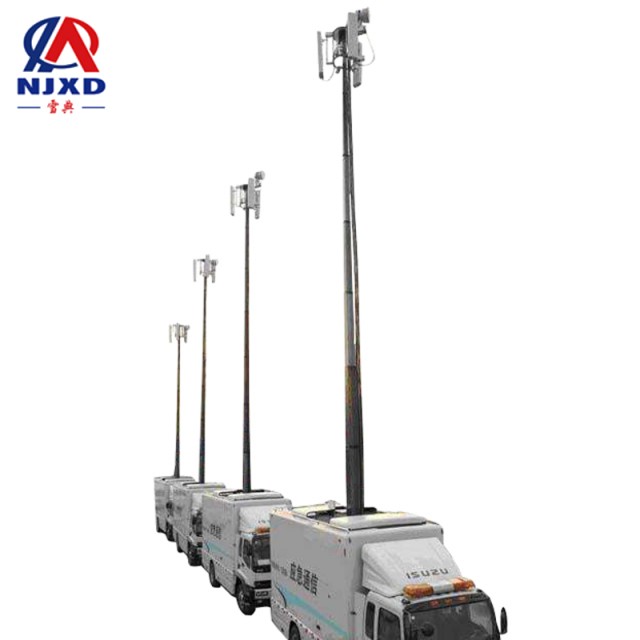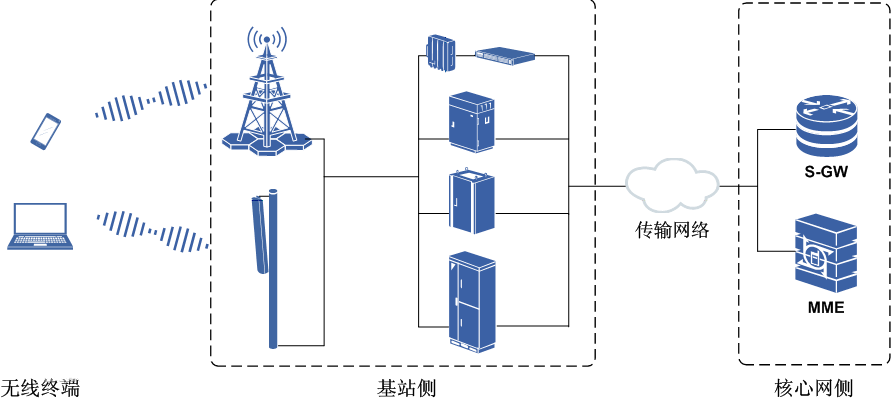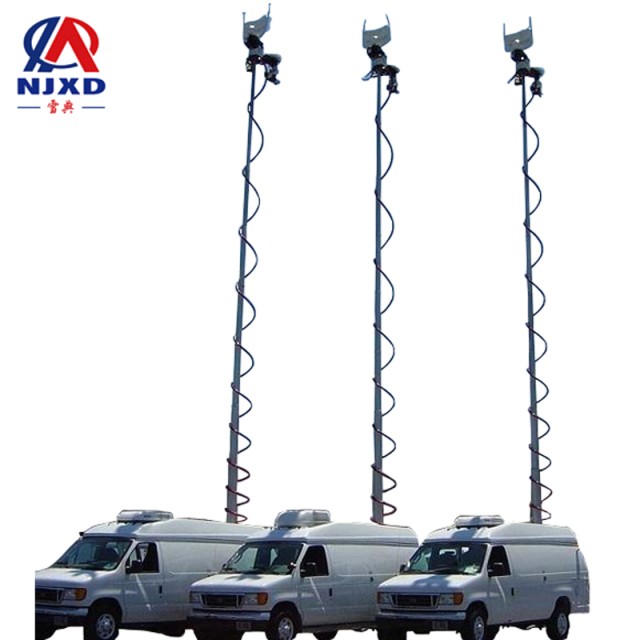NEWS
Working Principle and composition of emergency communication base station
Time:2021-08-12 View:

Base station is a public mobile communication base station, which is the interfacing equipment for mobile devices to access the Internet and a form of radio station. It refers to the mobile communication switching center in a certain radio coverage area, radio transceiver stations that transmit information with mobile phone terminals. The construction of mobile communication base stations is an important part of the investment of mobile telecom carrier. The construction of mobile communication base stations generally focuses on factors such as coverage, call quality, investment benefit, difficulty in construction, convenience in maintenance, etc. With the development of mobile communication network services towards data and grouping, the development trend of mobile communication base stations is bound to be broadband, large coverage construction and IP.
Definition
Base station, namely public mobile communication base station, is a form of radio station, which refers to the mobile communication switching center in a certain radio coverage area, radio transceiver stations that transmit information with mobile phone terminals. Simply speaking, the base station is used to ensure that our mobile phones can keep signals anytime and anywhere during the process of moving, which can ensure the needs of calling and sending and receiving information. The equipment with mobile signs on the pointed high iron tower that we see everyday is the base station. The base station sends and receives messages through the antenna.
Working Principle
The main function of the base station is to provide wireless coverage, that is, to realize wireless signal transmission between the wired communication network and the wireless terminal. Therefore, the location of the base station in the communication network is shown in the following figure.

The forward signal transmission process is as follows:
1. The control signaling, voice call or data service information on the core network side is sent to the base station through the transmission network (in 2G and 3G networks, the signal is first transmitted to the base station controller, and then transmitted to the base station).
2. The signal is processed by baseband and RF on the base station side, and then sent to the antenna through RF feeder for transmission.
3. The terminal receives the radio wave transmitted by the antenna through the wireless channel, and then degenerates its own signal.
The reverse signal transmission process is opposite to the forward process, but the principle is similar.
Each base station can contain one or more sectors according to the connected antenna. The coverage of base station sectors can reach hundreds to tens of kilometers. However, in areas with dense users, the coverage area is usually controlled to avoid interference to adjacent base stations.
The baseband and RF processing capabilities of the base station determine that the physical structure of the base station consists of two parts: baseband module and RF module. The baseband module mainly completes the functions of baseband modulation and demodulation, wireless resource allocation, call processing, power control and cross fade, etc. The RF module mainly completes the conversion between the air RF channel and the baseband digital channel, as well as the amplification, transceiver and other functions of the RF channel.

Composition
Infrastructure
Communication base station is the most critical infrastructure in mobile communication network. The mobile communication base station has structural components such as data center, wire, tower mast, etc. The base station room is mainly equipped with signal transceiver, monitoring device, fire suppression, power supply equipment and air conditioning equipment, and tower pole including lightning protection grounding system, tower body, foundation, bracket, cable and auxiliary facilities and other parts of the structure. According to the shape, the tower mast can be divided into angle steel tower, single tube tower, jacking Rod, cable tower and other different forms. Antenna is a three-layer structure of antenna frame, feed system and infinite reflector, which has two different application scenarios, indoor and outdoor. According to different transmission directions, the antenna can also be divided into directions and omnidirectional.
The choice of a base station needs to be considered comprehensively from various aspects such as performance, matching, compatibility and use requirements. Among them, it is especially noted that the base station equipment must be compatible or matched with mobile switching intermediate phase, only in this way can better communication effect be achieved. The base station subsystem mainly includes two types of equipment: base station transceiver station (BTS) and base station controller (BSC).
Base station location selection
The location of the base station must first consider the communication environment around the communication base station, comprehensively consider the base station density, signal, traffic volume, site conditions and other factors, and try to avoid strong electromagnetic interference, pulse interference area and a large number of flammable and explosive products commercial, near the warehouse. In addition, the communication base station should be built in a wide field of vision, and there should be no tall buildings around to prevent signal transmission of the communication base station. In the process of base station communication construction, the construction of data center, equipment installation and tower construction are all mechanical structures. High level of construction machinery and technology. Before construction, the geographical features of the construction area should be investigated to make full use of favorable terrain conditions, which is convenient for construction and maintenance.
Tower selection
The selection of the tower must first consider the geological conditions of the construction area, build the pile foundation scientifically, and select the appropriate tower type on this basis. Before formally carrying out the design and implementation of the selection of the Tower of the communication base station, it is necessary to conduct a comprehensive investigation on the geological conditions of the construction area to understand the geological conditions and possible geological risks of the construction area. On this basis, a series of effective methods are given. Response measures, select the appropriate tower type, comprehensively check the economic, technical and safety indicators, and select the appropriate tower form. For the base station of pile foundation communication, the selection of Tower must first consider the performance, crack resistance and settlement of pile body, and analyze and verify these performance indexes. The entire load of the communication tower is basically directly applied to the foundation. In order to improve the stability of the tower, special attention must be paid to the foundation construction. There are three different forms of tower foundation construction: Spread footing, single pile foundation and pile Group Foundation. If necessary, tension rod beams and anchor bolts can be added to resist the liquefaction treatment of the foundation to further improve the bearing capacity of the foundation.
Transceiver
Most people often see the high antenna on the roof, which is part of the base station transceiver station. A complete base station transceiver station includes wireless transmitting/receiving equipment, antenna and signal processing parts unique to all wireless interfaces. The base transceiver station can be regarded as a wireless modem, which is responsible for receiving and sending mobile signals. In general, in a certain area, multiple subbase stations and transceiver stations form a cellular network, the transmission of mobile communication signals can be achieved by controlling the mutual transmission and reception of signals between the transceiver and the transceiver. The area within this range is the network coverage we often call. If there is no transceiver station, it is impossible to complete the transmission and reception of mobile phone signals. The area that the base station transceiver cannot cover is also the blind area of mobile phone signals. Therefore, the range of signals transmitted and received by the base station transceiver is directly related to the quality of network signals and whether the mobile phone can be used normally in this area.
The base station transceiver station completes the conversion between the control of the base station and the wireless channel under the control of the base station controller, realize the transmission and reception of mobile phone communication signals and wireless transmission between mobile platforms through the air and related control functions. The transceiver station can decode and send the wireless signal of each user.
The antenna used by the base station is divided into transmitting antenna and receiving antenna, and it can be divided into omni-directional and directional. Generally, there are three configuration modes: omni-directional and omni-directional transmission and omni-directional reception; send orientation and receive orientation methods. Literally, we can understand the difference of each way. Sending omnidirectional signals is mainly responsible for sending omnidirectional signals; Receiving omnidirectional signals is naturally a directional reception signal; orientation means sending and receiving only at a fixed angle. In general, base stations with a small number of channels (such as those located in suburbs) often adopt omni-directional transmission and omni-directional reception, while base stations with a large number of channels adopt omni-directional transmission and omni-directional reception, and the establishment of base stations is also more intensive than that of suburbs.
Due to the weak signal transmission to the base station and certain signal interference, it is necessary to pass through the preselector.
Module filtering and amplification, double frequency conversion, amplification and frequency discrimination processing. The input high-frequency signal is amplified and sent to the first frequency converter. The frequency of the first local oscillation signal provided by the frequency converter is 766.9125-791.8875MHz. After downconversion, the first intermediate frequency signal of 123.1MHz is generated. After the first intermediate frequency signal is amplified, filtered and mixed, it generates the second intermediate frequency signal (21.3875MHz), which is amplified and filtered and then sent to the intermediate frequency integration block. The audio output signal and received signal strength indicator signal (RSSI) generated by the intermediate frequency integration block (including the second intermediate frequency signal amplifier, limiter and discriminator) are sent to the audio/control panel. In the audio signal control panel, the diversity switch continuously compares odd and even signals, selects the stronger signals, and transmits them to the mobile control center through the audio circuit.
The working principle of base station transmitter is to set the frequency provided by frequency synthesizer. The carrier frequency signal of 8875MHz and the modulated signal of 168.1MHz are filtered into the double balanced frequency converter respectively, and the frequency is. 9875MHz RF signal, the RF signal is filtered and amplified into the drive stage, the output power of the drive stage is about 2.4W, and then added to the power amplifier module. The power control circuit adopts negative feedback technology to automatically adjust the output power of the pre-drive stage or the push stage to keep the output power of the drive stage at the rated value. That is to say, the received signal is stably transmitted, which can effectively reduce or avoid the loss of communication signal in wireless transmission and ensure the communication quality of users. The function of the power amplifier module is to amplify the signal to 10W, but this is also based on the actual situation. If the radius of the transmitted signal in the community is large, power amplification module of 25W or 40W can also be used, to enhance the transmission radius of the signal.
Controller
The base station controller includes wireless transceiver, antenna and related signal processing circuit, which is the control part of the base station subsystem. It mainly includes four components: cell controller (CSC), voice channel controller (VCC), signaling channel controller (SCC) and multi-terminal interface (EMPI) for expansion. A base station controller usually controls several base station transceiver stations. Through the remote commands of the transceiver station and the mobile station, the base station controller is responsible for the management of all mobile communication interfaces, mainly the allocation, release and management of wireless channels. When you use a mobile phone, it is responsible for opening a signal channel for you. When the call ends, it closes the channel and leaves it to others. In addition, the handover of mobile stations in the control area is also controlled. If you enter the signal receiving and transmitting range of another base station when using the mobile phone, the controller is responsible for switching between the other base stations and maintaining the connection with the mobile switching center at all times.
GSM system adopts switching mode when crossing the area, that is, when the user reaches the boundary of the community, the mobile phone will cut off contact with the original base station first, and then establish contact with the base station of the new service community, when the new service community is busy, the call Channel cannot be provided, and then the disconnection will occur. Therefore, users should try their best to avoid using the blind area in four corners when using mobile phones to reduce the probability of call disconnection.
The core of the controller is switching network and common processor (CPR). The common processor controls and manages each module inside the controller and connects to the operation and maintenance center (OMC) through X.25 communication protocol. The switching network will complete the internal exchange of 64kbit/s data/voice service channels between the interface and the interface. The controller is connected to the mobile switching center through interfacing equipment digital repeater (DTC) and connected to the transceiver through interfacing equipment terminal controller (TCU), forming a simple communication network.
In the whole cellular mobile communication system, the base station subsystem is the bridge connecting the mobile station and the mobile center, and its position is extremely important. The communication quality of the whole cellular system is determined by the number of base stations in the whole coverage area, the location of base stations in the cell, and the working performance of related components in the base station subsystem. The selection and construction of base stations have become an important part of building modern mobile communication networks.

CATEGORY
NEWS
- Advantages and disadvantages of lifting xenon lamp and common faults
- Working Principle and composition of emergency communication base station
- 5G base station architecture and lifting antenna measurement technology
- Xenon lamp quality test lighting telescopic rod
- Outdoor Base Station wireless survey and design base station lifting antenna